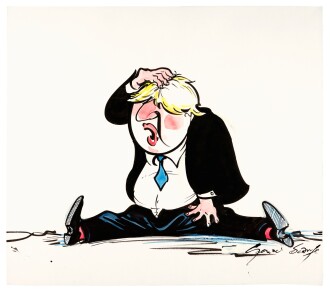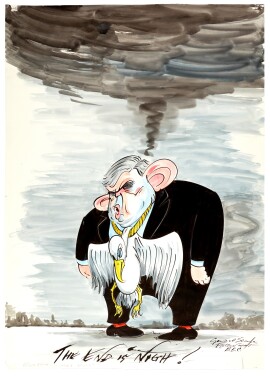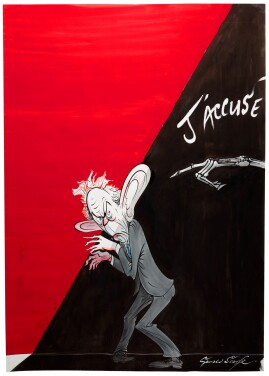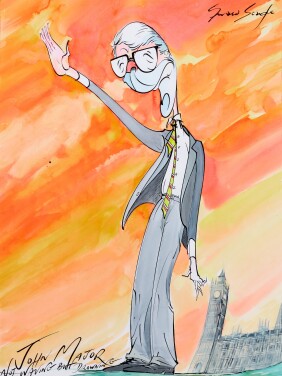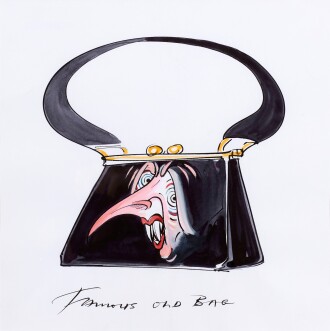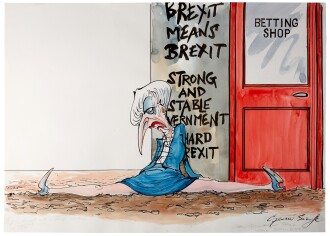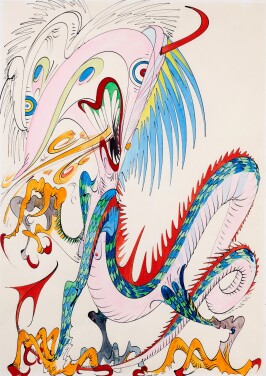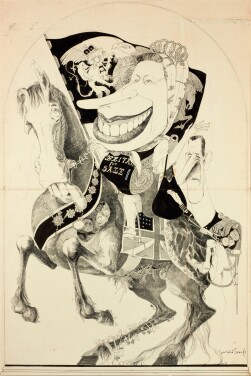"I have always been interested in doing the best drawing I can. There are other cartoonists who are happy with their idea, a funny idea, and they don’t necessarily care about the drawing itself. I have always cared tremendously what the drawing looks like, and I always do my best to organise it graphically and make it aesthetically pleasing even though it may be grotesque, even though it may be horrific.
Ideally I have to feel the flesh and bone when I’m getting a likeness. I can’t even add the eyebrows without feeling them. It’s like being a method actor or impressionist: I have to get into the mood and the feeling of that person. Often when drawing a character I can hear his or her voice in my head as I transfer that image to paper. The image I see in my mind’s eye is not fixed and can evaporate before it reaches the paper. To a certain extent there is a lack of control in getting to the end result. I try to free myself and fly away from the obvious, the mundane image, separate myself from the lazy photographic snapshot and achieve a boiled- down, distilled image that captures the very essence of that person. I have to uncouple myself from reality yet remain tethered to that person.
Gerald Scarfe Portraits of British Prime Ministers
My drawings are very personal acts made in the privacy of the studio in my home, but when they leave my hands they escape into hundreds of thousands of copies and may be seen by millions of people. I don’t think about that when I make the drawing – it’s just between my imagination and that piece of paper – but if a drawing is particularly ferocious or overtly sexual and someone looks at it in my presence I have to admit sometimes to feeling shy. I feel so personally about it, it’s almost like undressing in public. My drawings are often a cry against that which I detest, and in showing my dislike I have to draw the dislikeable. To horrify people with a drawing about the waste of war I must make a horrific drawing of war, and when I come to draw people, their bodies become vehicles for emotions – greed, lust, cruelty. It’s not that I have a dislike of human flesh: it is that I have a dislike of human frailties and the flesh becomes a medium for depicting them. However, as there is a percentage of prudery in my make- up I am embarrassed if, for instance, the drawing is highly sexual and the onlooker is shocked, even when that is what I set out to do.
Politicians have been my bed and board, my food and drink, my way of life. In a way I have lived off them, but in general I’m not particularly fond of them as a species. Many of them are blatantly ambitious, self-seeking, arrogant individuals who see themselves (incorrectly) as leaders. They love the power it can bring them and the flock of fawning sycophants who see them as their bread and butter and who follow them, picking up scraps. How extraordinary that they feel they have the answers to so many things and seek to persuade others to follow their lead. Does it never strike them they could be wrong? Having said all that, by the law of averages I must admit some politicians have the best intentions. They genuinely feel they want to and can change our world for the better. The rest – the majority – are a necessary evil.
Highlights from Scarfe at Sotheby’s: Sixty Years of Being Rude
I often went to the party conferences. In the days before the internet changed the world and gave us the ability to research people at the click of a mouse, and long before the days of twenty-four-hour news, I needed to go and seek them out. Blackpool or Brighton at conference time is the natural habitat of the politician. I was able to draw them unobserved – braying at breakfast, basking on the prom, lolling at their watering holes, snorting at the best troughs in town, slumbering in the afternoon boredom of unmemorable speeches. The Times foreign correspondent Louis Heren once said we should approach all politicians by asking ‘Why is this lying bastard lying to me?’ Politicians say, ‘Let me be perfectly clear about this’ – meaning ‘I’ll fog this up and hope to get away with it’. They say ‘To be honest’, which means ‘I’m going to lie through my teeth’. Many politicians have the astounding arrogance to think themselves superior beings who have a duty to tell other citizens what to do, where to go and how to behave. They are not quite as bad as religious bigots but they are getting close. Somewhere I acquired or inherited a strong dislike of authority, of people throwing their weight around. I cannot bear bumptiousness, superiority, those who think themselves a cut above others because of birth or money. Those who misuse their power drive many of my drawings. What arrogance and stupidity makes a mere mortal think he is the one chosen to lead others?
I find that when a new politician is elected to high office and it becomes necessary to caricature him or her, at first it may be difficult to understand how they should be depicted. They could be drawn in an almost realistic likeness with only slight exaggerations – a marginally bigger nose for instance. Then drawing by drawing, week by week, the exaggerations become more extreme and distorted as I come to understand the face more. The advantage of working on a daily or weekly newspaper is that the readers can be slowly led over time to accept the extremes of caricature.
Cartoonist Gerald Scarfe on Pink Floyd, Politics and Pterodactyls
Drawing politicians over and over again is a tedious business and I’ve always looked for new ways to depict them to relieve the boredom. A public figure can become a symbol. I get a particular satisfaction from drawing politicians as animals. I saw Harold Wilson as a crafty old warty toad, puffing and swelling with self-congratulatory pride. James Callaghan was a sly old pig, snuffling and snouting for truffles in the political sty. Enoch Powell was the Hound of the Baskervilles, baying for immigrants’ blood. Edward Heath became a beached whale. Richard Nixon was the old rogue Republican elephant, a sad, sagging leather sack hung on whitened bones, bleached in the heat of the Watergate sun. I drew George Bush (Dubya) as a bewildered ape, his close-set eyes beneath a wrinkled and puzzled brow, his knuckles scraping the ground as he wandered aimlessly, his arse stuck out behind with ‘Iraq’ branded on his buttocks. All in the name of God. Permanently licking Bush’s backside was his sidekick, the poodle Blair. Also, more recently, Putin – the unpredictable Russian bear, code name ‘Novichok’. And now there’s one of the worst of them all, the vain, pussy- grabbing Trump: a pile of horseshit. A ‘shithole’ president for sure, to use the word he used about African countries.
Yes, it all went very, very wrong in 2017. A rogue president moved into the White House. An immature bully, a vicious racist, a cruel misogynist, an arrogant bigot, an insecure braggart and a compulsive liar – altogether a very nasty piece of work. This awful man immediately became my muse. He inspired me. From his daily deranged utterings and appalling ways I produced drawing after drawing. It became a flood, a tsunami. It was the only way I could express the fear and horror I felt. How could it have happened? How irresponsible to put such a dangerous beast in the most powerful position in the world. One should never say ‘never’. Now we have Prime Minister Boris – an ambitious, Machiavellian, foot-in-mouth clown.
Caricature comes as much from a study of the character. One could not portray Donald Trump as anything other than a raving idiot, a man who keeps losing it. It is not just a man with a big nose or big ears: a successful caricature should encompass the whole character. The way someone stands, walks, sits, talks and gesticulates can say a lot about who they are.
Do politicians hate being caricatured? Most of them love it. Swollen egos, thick skins and ambition. ‘It’s all a game,’ Jeffrey Archer told me. Well, of course he is right. When a politician is caricatured in the national press it means he has arrived, he is now a person of note. Some object, though. Denis Healey once bore down upon me at the Labour Party Conference in Blackpool. ‘Look!’ he said, jabbing a finger in his mouth. ‘My teeth are not – not – as big as you draw them!’ They were. (Perhaps the iciest brush- off I’ve ever received came when I was sketching Prince Philip as he moved among invited guests at the Royal Geographical Society. As I glanced up from my sketch book an equerry blocked my view. ‘You have incurred the Royal displeasure,’ he hissed. I got the picture.)
I don’t really want to meet the politicians I draw. I might dislike them personally, which should be irrelevant; I need to make drawings of them from a distance, which show what is wrong with their policies, or their personalities. Inevitably, on occasion paths have crossed. Invited to spend a week with some friends in Tuscany one year we found one of the other guests was David Blunkett, the former Labour Home Secretary. David is blind, so I found myself offering my arm and guiding the man I had unkindly caricatured so many times over the rocky Tuscan hillsides on walks. We chatted about this. He didn’t seem upset by my drawings of him – but then he’d never seen them."
Gerald Scarfe's autobiography Scarfe: Sixty Years of Being Rude is available now
